Interview with Billax
5February 9, 2015 by Ville Raivio
VR: Your age and occupation?
Products from Pukimo Raivio
Ralph Lauren, Black Label suit, size 52EU
B: I was born in Chicago in 1942. Tomorrow, I’ll turn Seventy-three. After college, almost all my working life centered on the securities of technology companies – from Venture Capital investing in start-ups, to Investment Banking for companies undertaking Initial Public Offerings, and directing researchers who analyzed the investment merit of public companies, on to managing portfolios of technology securities, and, most appealing to me, speculating on opportunities that would be created by new technologies. I was very lucky to have had such endlessly fascinating and challenging work!
Barred owl spotting
VR: Your educational background?
B: I graduated from a Midwestern University in 1964, having majored in Industrial Engineering and Business Administration. I chose my college for the most rigorous of reasons – my High School sweetheart was gonna go there, and they offered me an Athletic Scholarship to run and jump for them! Such failure to focus on the central factors in an important decision would episodically haunt me throughout my life. Still, serendipity befell me often enough so that everything kinda balanced out. As I entered college, my vague career goal was to be a car designer for Jaguar or Ferrari. Sometime early in those college days, that dream sloughed off and slid away. Nonetheless, I still sketch sleek automobiles while sitting in the waiting room of my auto repair shop. And, yes, I do notice that my drawing hand isn’t as steady as it once was. :-)
I was fortunate to make the Dean’s List several times in college. I also made the Dean’s “One more time and I’ll boot you outa here!” list. For a brief period, my future wife thought the song the best fit me was a Country and Western ditty by Faron Young, entitled “Live Fast, Love Hard, Die Young.”
“As a Junior in college, 1962: corduroy sport coat, tabbed club collar shirt, obligatory skinny tie of the era.”
VR: How do your wife and children relate to your style enthusiasm?
B: That I didn’t die young was the result of two women who believed in me: My wife of fifty-one years and my business partner of 31 years. I am grateful to them both. They both believe my apparel fetish is a genetic defect with which they have learned to live. As to my three Sons, the oldest has zero interest in clothes and has his wife buy his clothes and suggest what he wears. The other two boys are natural shoulder dressers, from their Brooks Brothers 132Q button-downs, right down to their Allen-Edmonds Strand shoes.
“1963: Best dressed male on Campus.”
VR: …and your parents and siblings’ reactions back when you were younger?
B: Neither of my parents dressed stylishly. Nor did my brother or sister. They always looked tidy, but they just didn’t pay much attention to clothes – and that included mine. Of course, in the late 1950s and 1960s, wearing the Ivy League Look was like putting on the Cloak of Invisibility. Since almost all the guys who thought about clothes wore the same look, nobody paid any particular attention to someone wearing Ivy gear. I was merely EVERYMAN.
VR: What other hobbies or passions do you have besides Ivy gear?
B: My wife and I love modern Architecture. In particular, I love the so-called Organic branch of modern architecture. We have purchased, restored, and lived in four modernist houses – all of which came with the original plans. In addition, I wrote and had published a monograph on the architect of one of the houses we owned. Our library is weighed down by more than 200 architecture and modern design books. It has been an interest of mine since my Dad gave me a copy of the Herman Miller collection in 1952, nearly sixty-three years ago. The book was co-authored by two architects and furniture designers, George Nelson and Charles Eames. Their simple, minimalist, form-follows-function furniture is what I have lived with for a long time. That furniture, and the modernist architecture with which it fits, has a certain parallel with the Ivy League Look. They share design principals of minimalism, no (or very little) ornamentation, and the belief that form follows function.
My other passion is Lacrosse, a Native American game that has been played for more than 600 years. The game was used as a dispute resolution method between tribes, and the game is called – by Native Americans – the Little Brother of War. I became involved with Lacrosse on a long-ago day when my youngest and I were sitting in a city park, waiting for his Little League Baseball practice to start. He saw three lacrosse-playing boys from the local High School team having a catch, with helmets and gloves on and sticks in their hands. He watched this fast, fluid game for a couple of minutes, turned to me and said, “Da, that’s the game I want to play. What is it?” Those two sentences changed my life. Valuing the traditions of long ago came to be something I cherished. That formerly un-exercised part of me also reinforced my interest in traditional apparel! My youngest recently turned 21. He continues to play the game to this day. On Spring days, whenever there’s a game, you’ll find me sittin’ in the stands, at his college Lacrosse Stadium, as he and his teammates do battle with other NCAA DI lacrosse teams.
“J. Press handwoven Donegal Mist 3/2-roll jacket, cable knit Cardigan vest, and Light-gray flannels.”
VR: How did you first become interested in style, and when did you turn your eyes towards the classics? Why Ivy style above others?
B: In November of 1958, my family hosted the Thanksgiving Dinner for both sides of our family. I was a Sixteen-year-old High School Senior, already at work on my college applications. My two college-attending male cousins arrived, dressed in very similar outfits. Both were wearing Bass Weejuns, Wigwam wool crew socks, pressed khaki pants with cuff/no break and white Oxford Cloth Button-Down shirts. Both wore Shetland sweaters – the Northwestern cousin a Caramel Tan V-neck and the Cornell cousin a Gray crewneck. I was stunned. Those were the best looking rigs I had EVER seen! Every component seemed to fit perfectly with every other component. It all seemed so… so… coherent to me! I did not know that the cousins were wearing something called The Ivy League Look, I just knew that I wanted to wear that AND NOTHING BUT THAT! There was nothing loud about the cousins’ apparel. The colors were quiet, the shirt collar and trousers were crisp, and, except for the Weejuns, nothing was shiny. To a color-blind guy like me, each of the guys looked just PERFECT.
I came to find out that The Ivy League Look was the dominant menswear look on college campuses throughout the nation. It had been that way for about 15-20 years and would remain that way for another decade. I’d seen David Nelson of “The Ozzie and Harriet” television show wear similar things (he was then a college student at USC and a member of Kappa Sigma fraternity) and I liked them. But seeing those apparel elements in person, being driven nearly crazy by the deep, dense, textured, Shetland wool, the perfectly creased Khakis, the slouchy wool socks, and the shine on the “Brush-off” Weejuns caused me to say to myself, “Why would anyone ever wear anything but this kind of clothing?” Fifty-six years later, I still think the same thing!
“Club wear: 3/2-roll tweed jacket, 6 button vest, brown suede loafers.”
VR: How have you gathered your knowledge of the tailored look — from books, talks with salesmen or somewhere else?
B: When I arrived at college in the Fall of 1959, I quickly spotted the Campus “Ivy” shop. I walked in, wearing the one outfit I’d copied from my cousins. Richard Ross – Dick to his friends – Mr. Ross to me, was the proprietor. He was a diminutive Scottish gentleman, with only a trace of a burr. As I walked in, he greeted me, though I was in the midst of being dumbstruck by the tie table, the shirt shelves, the tweed sport coat racks, the reversible outerwear. It was too much for me! I blurted out, “Hello! I would like to work here part-time, as I’m a student at the University and I just pledged Kappa Sigma and I’ll do it for free if I have to.” Yup, that was the world’s longest run-on sentence, but I needed to get it all out in one breath!
He smiled, and gently asked, “What do you know about clothes?”
Without thinking I said, “I know nearly nothing and I want to learn nearly everything!”
Well, he hired me and I worked at his store part-time for close to four years. He taught me how to think about, and describe, collar roll. He meticulously compared the two shirt brands we carried, Gant and Sero, so that I could help customers find the best shirt for them. He let me sit in on the conversations he had with the sales reps who came calling. They usually repped (represented) more than one line. Our Gant guy repped Reis of New Haven ties as well. I was in heaven as I listened to the rep pitch Mr. Ross, and heard Mr. Ross asking the tough questions. Sitting silent, I thought to myself, “Someday, I’d like to know enough to ask the tough questions.” Much later, I’d learn to ask tough questions, but that was in a different industry and at a different time.
Mr. Ross was my mentor. He taught me everything. In return, he expected perfection from me. For example, the phrase, “Cuff/no break,” was not just a good idea, it was THE LAW if you worked for Dick Ross. Every day I worked, I’d come in and he’d look me over. If my pants had a break, he’d gently say, “Bill, adjust your braces.” I didn’t wear braces – he knew I wore a belt. That was just his gentle way of saying, “Fix it, Bill!!” After a few more episodes of “big break,” he blurted out, “Bill, it is better to endure the occasional flood than to live in a perpetual puddle!” At that point, I got it. There was never any break in my trousers again!
A couple of years into my part-time job, Mr, Ross asked me to represent his store in the University’s “Best Dressed” competition. I felt that all that I’d learned from him would stand me in good stead. It did! I was named the Best Dressed Man on Campus. I had learned so much from him.
Mr. Ross was the only person who mentored me in apparel. For the rest of my life, mistakes have been my teacher. I have made many, and I’ve had to address them on my own. For better or worse, I’m an analytic guy. I LIKE to analyze problems, find out what went wrong, and work to find solutions. Being colorblind is not the least of them. Thinking through fit issues is just another issue. I’ve come to know what I want, and how to describe what I want to both retailers and tailors. There may be better, cheaper, and faster ways to learn the drill, but I found my way – and it works for me.
VR: How would you describe your style?
B: When I look in the mirror in the morning, I shake my head and say, “You’ve sure become a flamboyant old geezer!” Somehow, in my old age, the Madras jackets are a little bolder, the trousers colors a little brighter, and the pocket squares ride a little higher in my breast pocket. Somewhere along the way, those perfectly beautiful neutrals I started out with have mutated into something more bold. I don’t understand why. It just is.
VR: Which tailors or RTW makers do you favour and why?
B: First, I am a Ready To Wear guy and, with one exception, always have been. About 30 years ago, though, I thought the next step in my sartorial development would be to start on the bespoke tailoring path by having a suit measured, a pattern made, cloth selected, and three or more fittings undertaken. Long story short, I loved the suit, but ended up hating myself. I learned that I’m a RTW guy. It’s just how I’m wired.
I give my ready to wear tailored clothing business to: The Andover Shop, Ben Silver, Brooks Brothers, J. Press, and O’Connell’s. Most of my purchases come from Internet orders. The only vendor who would recognize me when I called or visited would be Jim Fitzgerald at J. Press.
It’s much harder buying today than it was a decade ago! Adjusting for all the new Brooks Brothers models, the various J. Press manufacturers, each using their own patterns and their own interpretation of natural shoulder, O’Connell’s with several sport coat and suit manufacturers, each using different patterns, is painful. Add to this the advent of vanity sizing, with a 42R today measuring bigger than the 42R of a decade or two ago. My actual chest measurement remains 42, but in, say, Brooks Brothers Madison or Fitzgerald fits, I was once a 42R, but have become a 41R. It takes a lot of work to keep up with the changes vendors make!
If the question had been, “Who are you rooting for? among RTW clothiers” my answer is, and always will be, “I root for the little guys!” J. Press, The Andover Shop and O’Connell’s.
VR: Have you any particular style or cut philosophy behind your items?
B: Yup! Here are Billax’s stupid rules: 1) In the Ivy League Look all cinches, closures, and adjusters are invisible when standing. 2) In the Ivy League Look all ornamentation is exposed when standing. 3) When rules 1 and 2 are in conflict, rule 1 takes precedence.
VR: Who or what inspires you?
B: Charlie Davidson of The Andover Shop and the Huber men of O’Connell’s. These entrepreneurial guys opened for business in 1953 and 1959, respectively. By 1967 one could hear the death rattle of Ivy style. A thousand Ivy retailers shuttered their doors. Only a handful remain. Gotta admire the grit of these gentlemen!
“Summer garden party wear: 3/2 Navy Hopsack Blazer, Seersucker vest, linen trousers, and Spectator wingtips.”
VR: What’s your definition of style?
B: The following definition resonates with me: A distinctive appearance, typically determined by the principles according to which something is designed. In Architecture, Automobiles and Ivy League Men’s apparel this definition is applicable.
VR: Finally, what can Keikari’s readers learn from traditional American dress?
B: I’ve written that there are four sub-styles of the Ivy League Look: Campus, Country, City, and Club. Of these, I believe the Campus look best reflects the American character. When Yale introduced a Dress Code in 1952 that required a coat and tie to enter the Commons (the University-wide dining room at that time), Yalies responded by complying with the letter of the law. The Spirit of the Law? Not so much! One can see pictures in Take Ivy (taken in 1968) of Yalies walking on campus in Bermuda shorts, OCBDs and Madras sport coats… wearing ties. Americans have never much liked to be told what to do! By the way, as Yale declared, in 1968, that they would admit women for the 1969-70 Academic year, they also abandoned the Dress Code!
“Cords, Orvis 3/2-roll Horse Blanket plaid, Polo coat. I am a country guy.”
Photos: the Billax home archives
Category American style, Interviews, Men of style | Tags:

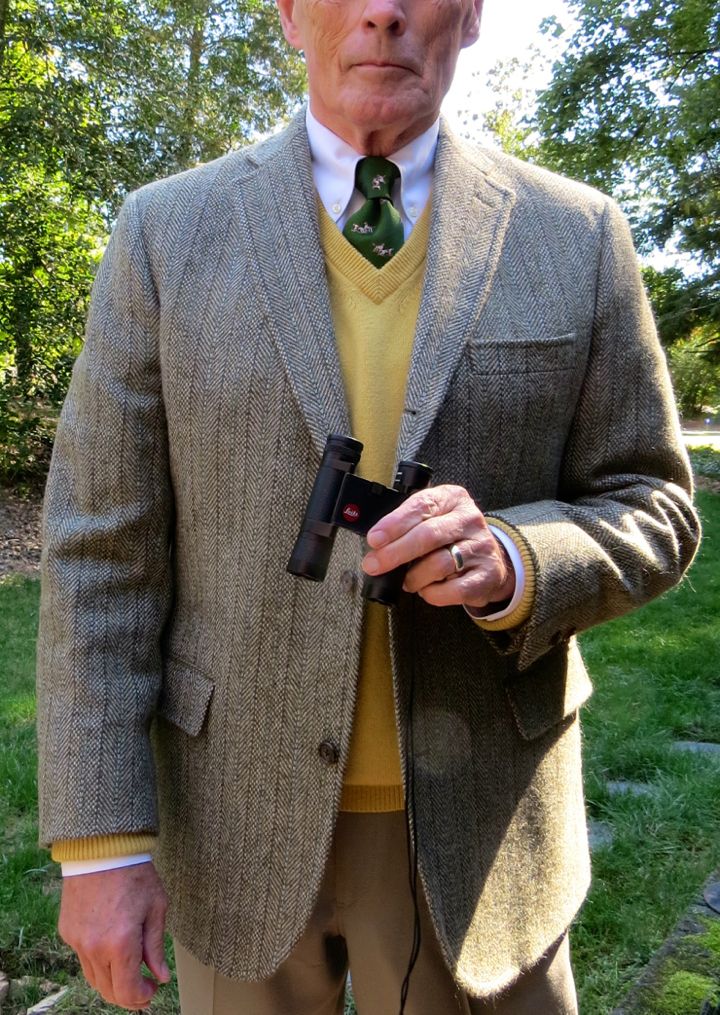
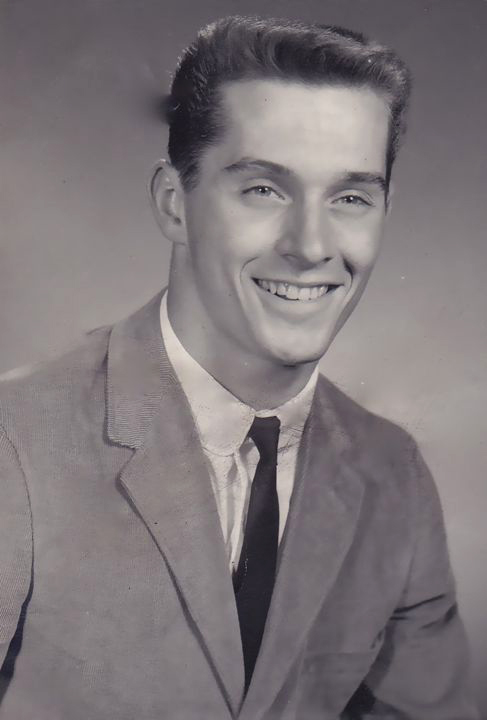
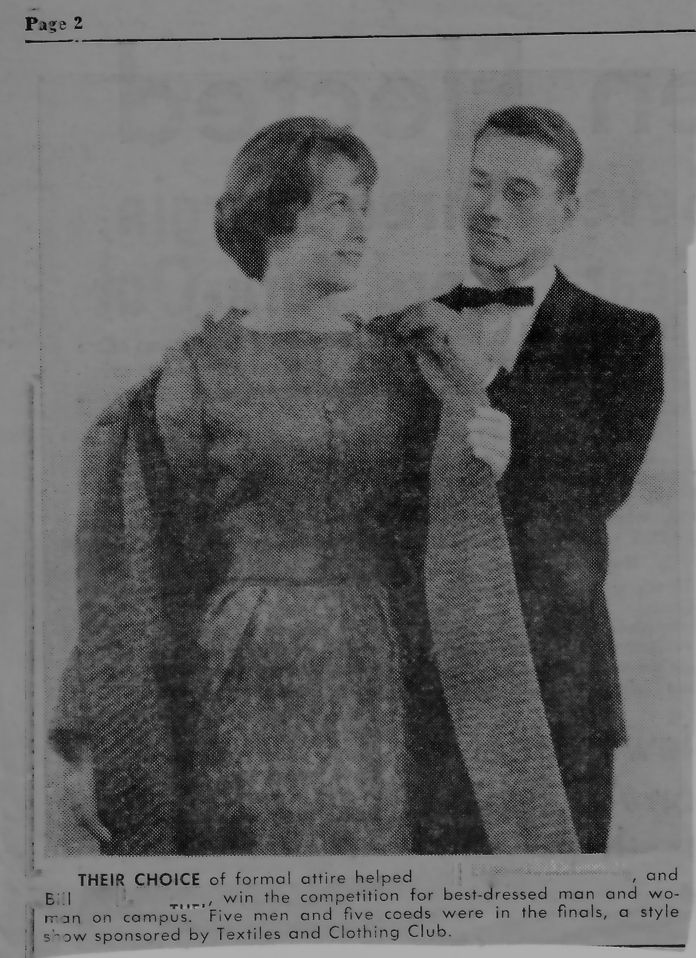
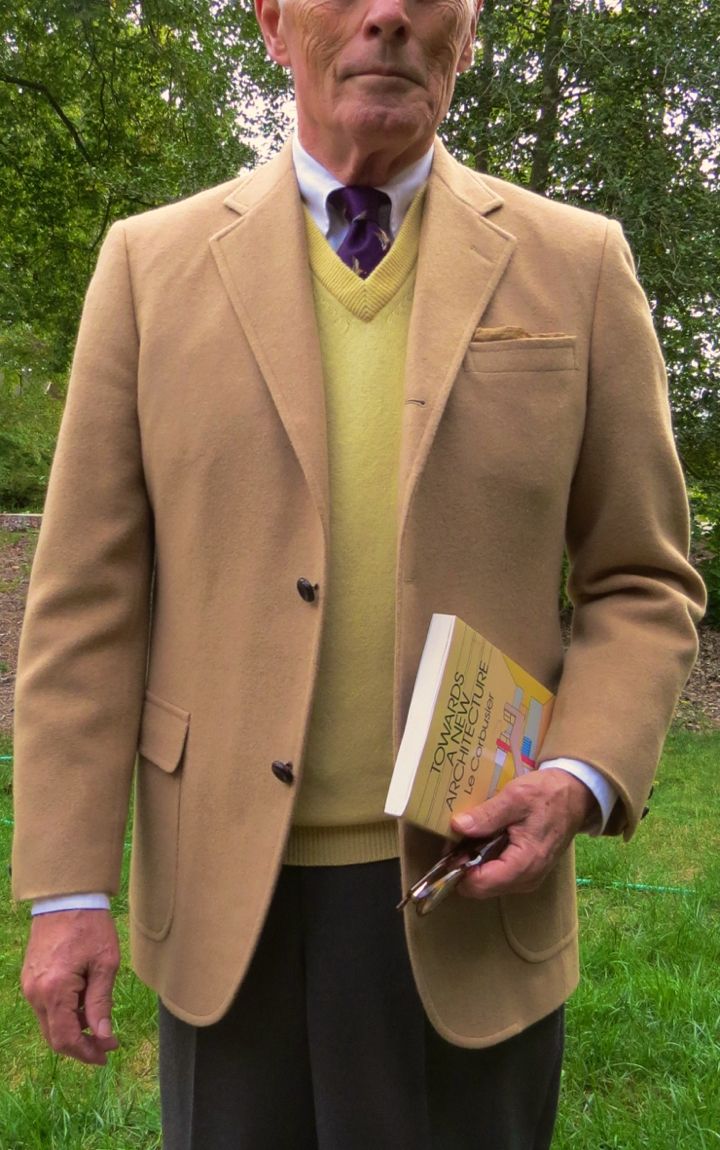
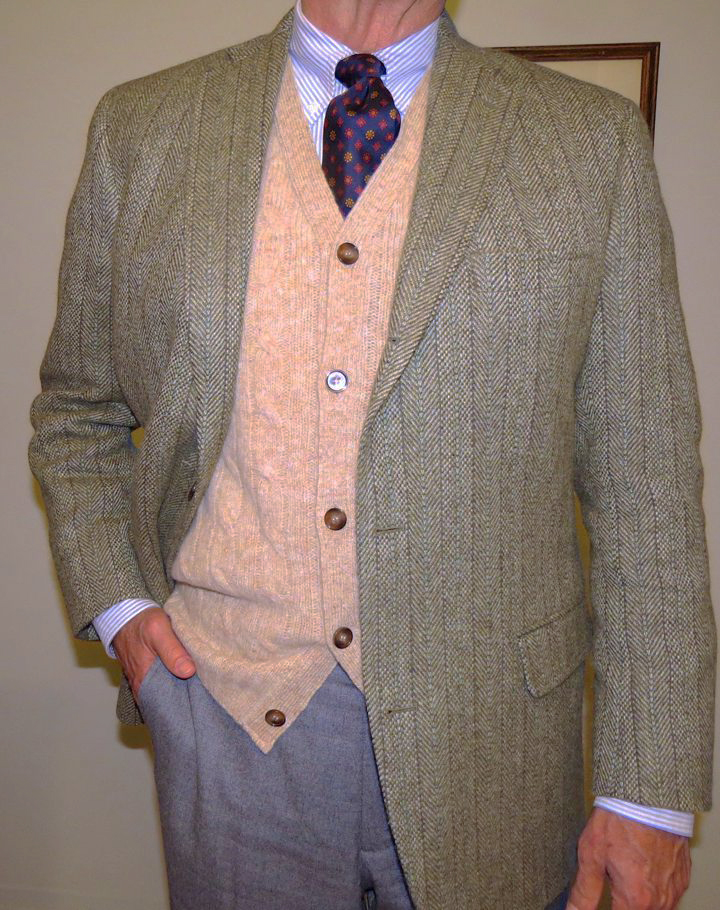
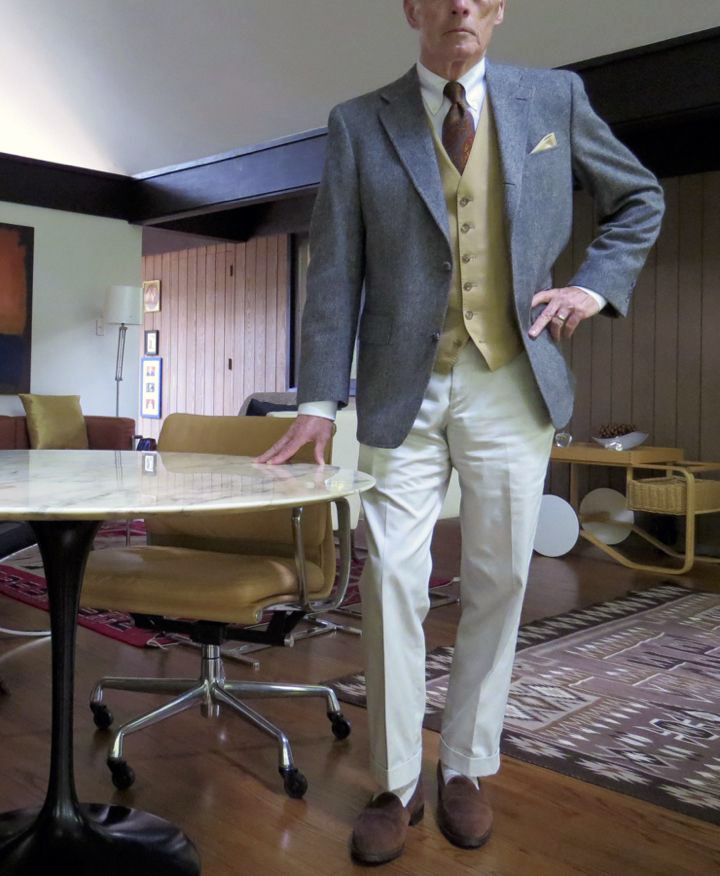
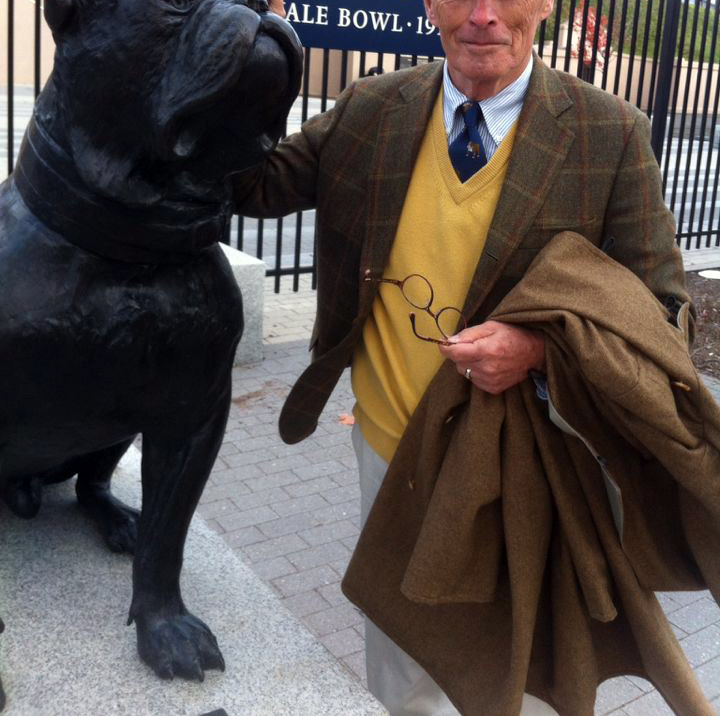
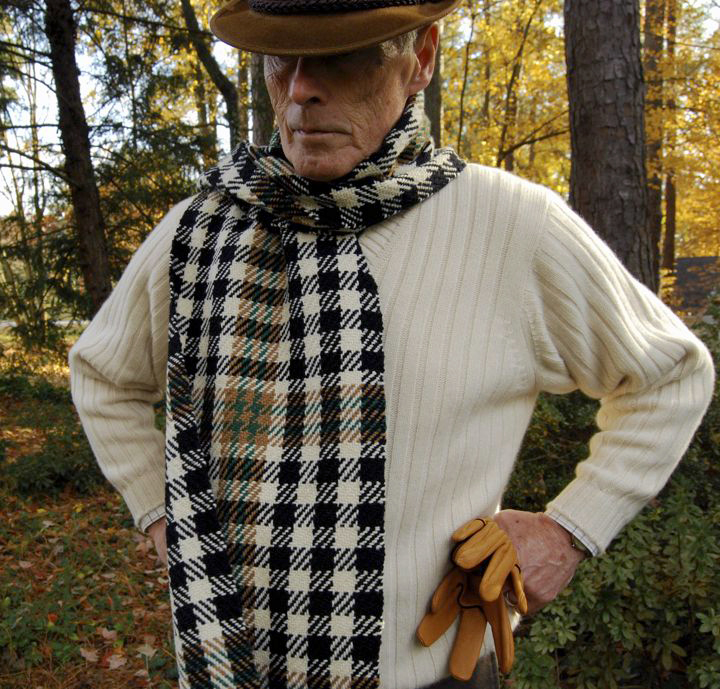
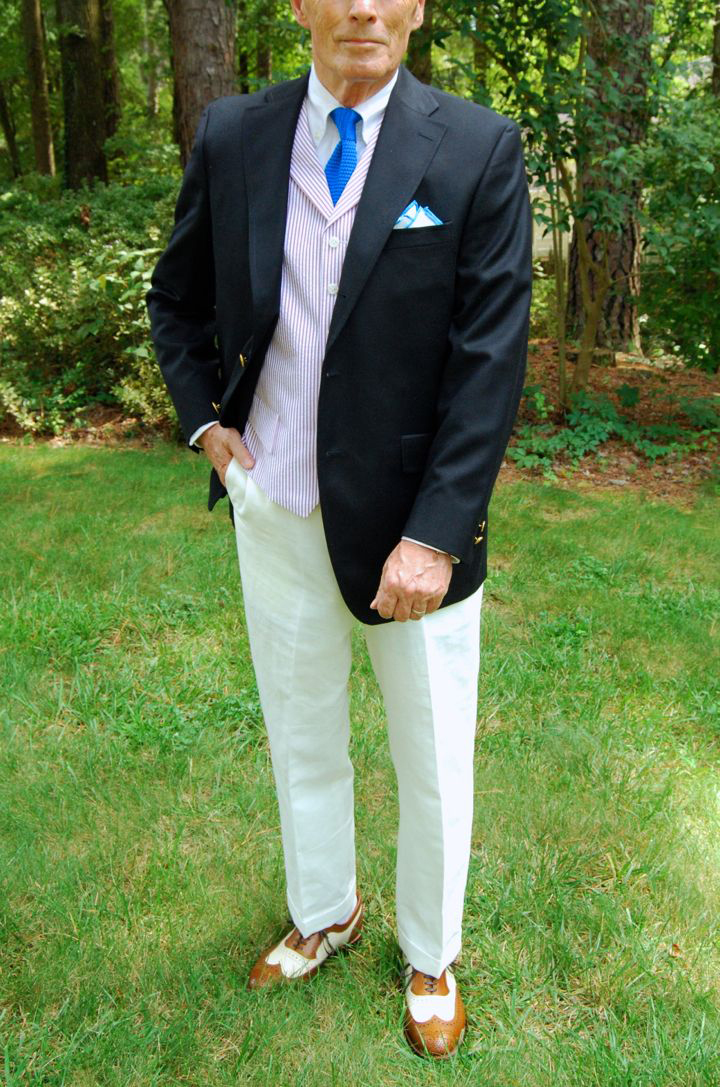
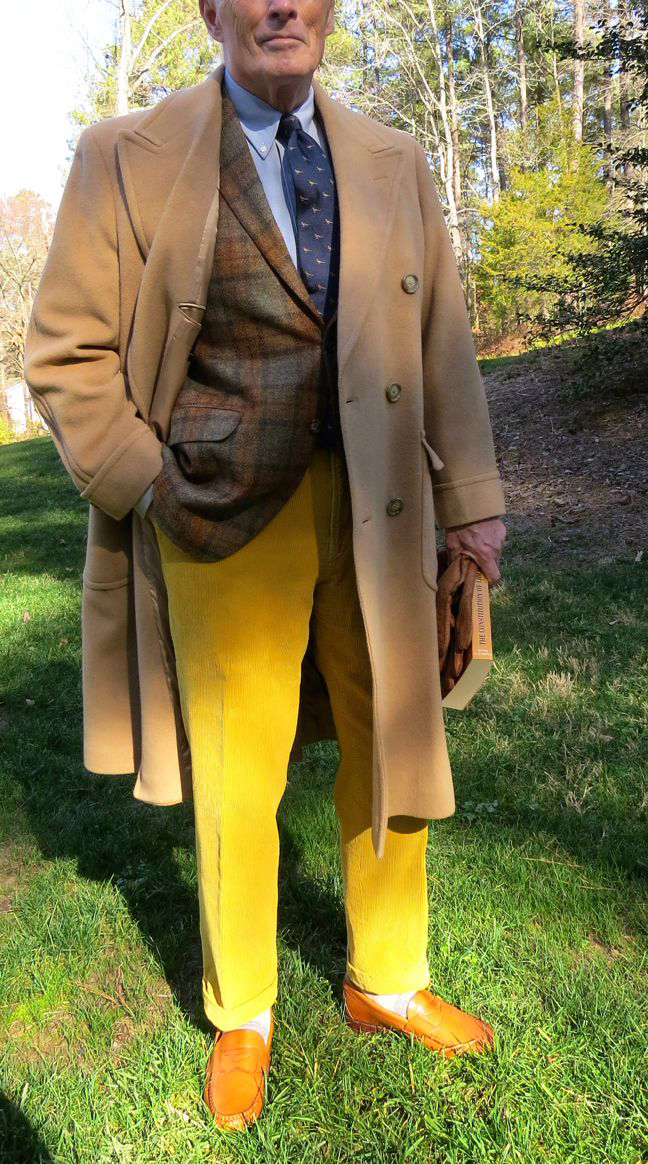


jadore ce que vous porté et vous le porté bien
The best dried in the wool example of died-in-the-wool trad example of fabulous dresser!
Thanks, Gents!
I enjoyed the interview and hope you got something from it as well!
Best,
Billax
Fabulous..!
Great interview with a great, died-in-the-wool trad dresser.
His outfits, style and coordination has been, and continues to be an inspiration to many who aspire to his, clean, simple, understated yet undated look.